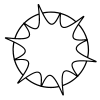Have you ever had that uncomfortable feeling where your lower back feels stiff, painful, and restricts your movement? Lower back pain is a common discomfort, often caused by our daily activities or, sometimes, by the lack thereof. In this article, we share simple and accessible movements to help you regain a sense of comfort.
Causes of Lower Back Pain
Prolonged poor posture
Spending hours hunched over a desk or slumped on a couch can lead to muscular back pain. These prolonged positions put excessive pressure on the spine, overstraining your lower back muscles. Over time, this poor posture can become habitual and lead to chronic pain. Regularly adjusting your posture and incorporating stretching into your daily routine can reduce this tension.

Strained or injured muscles and ligaments
Muscle back pain can also occur after a sudden movement, a false move, or a workout that's a bit too intense. Muscles stretched beyond their capacity or overstretched ligaments can cause pain that limits your range of motion. The key is to gradually strengthen your back and abs while adopting a healthy exercise routine.
Intervertebral disc problems
Intervertebral discs play a crucial role in absorbing shock in the spine. However, when these discs become displaced or damaged, it can cause back pain and stiffness. While this type of issue should be addressed by a professional, targeted stretches can help relieve the surrounding muscles.
Stress and muscle tension
Stress isn't just in your mind: it can affect your body. Many of us store tension in our backs, which can lead to muscular back pain. Learning to manage stress, through meditation or relaxation, can go a long way toward reducing this pain.

Sedentary lifestyle
With a sedentary lifestyle, your back muscles become stiff and lose flexibility, opening the door to back pain. Sitting for too long can worsen the condition, limit your mobility, and cause long-term pain. Adding active breaks and regular stretching can reverse these effects.
Aging and wear of the joints
With age, joints, including those in the lower back, undergo natural wear and tear. This deterioration can lead to pain, sometimes accompanied by backache. While accepting age-related changes, you can maintain good mobility by taking care of your muscles and joints with the right exercises.
10 Effective Moves to Relieve Lower Back Pain
Lying Lower Back Stretch
This simple yet effective exercise helps relieve tension in the lower back while promoting better relaxation. By bringing your knees toward your chest, you gently stretch your lower back muscles, which are often tense due to poor posture or daily stress. Remember to breathe throughout the stretch to maximize its benefits.
-
Number of repetitions: 2 to 3 times
-
How often: Every morning and evening
Stretch your lower back with a Bloon ball
The Bloon Ball provides optimal support for your lower back while allowing for a progressive stretch. Try performing a bridge position on the Bloon Ball. While stretching, be sure to maintain a steady breathing pattern to help relax your back muscles.
-
Number of repetitions: 3 cycles of 20 seconds
-
How often: Once a day, as needed

The "sphinx" stretch
Inspired by yoga poses, this stretch helps reduce lower back stiffness caused by hours spent sitting. By gently raising your upper torso, you promote excellent lumbar extension while decompressing your vertebrae. Be patient if you feel any tension, and adjust the height to your comfort.
-
Number of repetitions: 2 times with 30 seconds of holding
-
How often: 3 to 4 times a week
Hamstring Stretch for Better Posture
Tight hamstrings increase pressure on the spine, and this stretch is a gentle solution. As you lean your torso toward your feet, gradually relax these muscles, avoiding any sudden movements. Focus on a slow approach to maximize its effectiveness.
-
Number of repetitions: 2 to 3 times, 20 seconds per leg
-
How often: 5 days a week

Pelvic tilt
This exercise is excellent for regaining fluid mobility in the lower back, correcting minor stiffness that often causes persistent pain. The gentle incline stimulates the deep abdominal muscles while engaging your lower back without straining.
-
Number of repetitions: 10 back and forth
-
How often: Morning and evening, regularly
The pigeon stretch
Ideal for effectively releasing tension, this exercise, well-known among yoga practitioners, targets deep muscles that are often overworked. By combining flexibility and relaxation, it also relieves radiating pain caused by muscular back pain.
-
Number of repetitions: 2 times per leg, 30 seconds hold
-
How often: 2-3 times a week depending on your needs

The extension of the quadruped
This dynamic exercise aims to improve core stability while strengthening coordination between different body regions. The balance required to maintain the position engages the deep stabilizing muscles, promoting better posture.
-
Number of repetitions: 5 times on each side
-
How often: 3 times a week
Hip flexor stretch
By engaging this often underused area, this exercise not only helps prevent back pain but also improves posture. Gently push your hips forward to feel a pleasant, progressive stretch.
-
Number of repetitions: 3 cycles of 20 seconds per side
-
How often: Daily, especially after a day of sitting
The seated twist
This accessible and gentle twist helps release accumulated tension throughout the spine, while promoting better spinal mobility. Adopt a slow and controlled twist to maximize the effectiveness of the exercise.
-
Number of repetitions: 2 repetitions on each side
-
How often: 4-5 times a week

Lateral sheathing
Strengthening your core muscles is essential for preventing long-term lower back pain. Side planks engage a wide range of muscles, strengthening not only your abs but also your lower back and obliques. Maintain proper posture throughout the exercise.
-
Number of repetitions: 2 times of 20 to 30 seconds per side
-
How often: 3 times a week
In conclusion, lower back stretches are an effective and accessible method for relieving lower back tension and improving mobility. By regularly incorporating them into your routine, you can promote better posture, reduce discomfort, and support your overall well-being.












